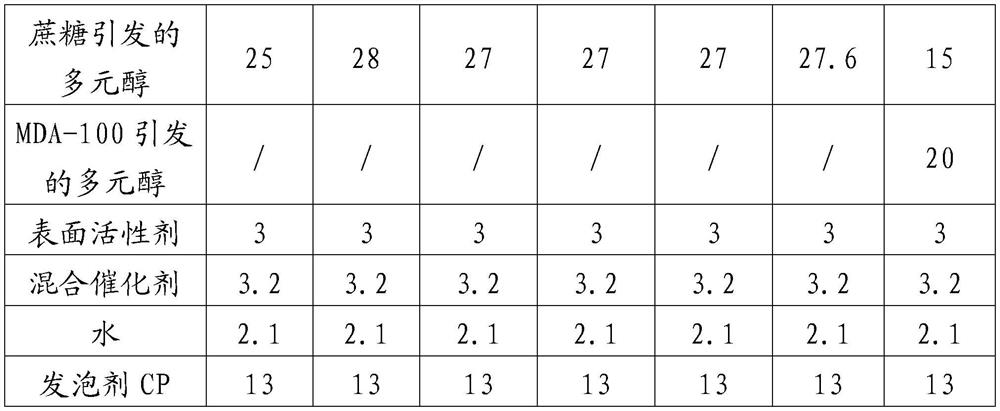Amino polyether polyol and its preparation method and application
A polyether polyol and amine-based polyether technology, which is applied to the field of amine-based polyether polyol and its preparation, can solve problems such as affecting product quality, affecting product production, and difficulty in cleaning the reaction kettle, thereby saving production time and improving The effect of production efficiency and superior mold release performance
- Summary
- Abstract
- Description
- Claims
- Application Information
AI Technical Summary
Problems solved by technology
Method used
Image
Examples
Embodiment 1
[0053] Example 1 is a comparative example of preparing polyether polyol by using o-phenylenediamine, and the o-phenylenediamine is melted by a high-temperature melting method. Follow the steps below:
[0054] Add o-phenylenediamine (570g, 5mol) into the reaction kettle, replace with nitrogen and test the pressure, set the temperature of the kettle to 110°C, start stirring and heating for 1h (this time is in the scale-up experiment, it is found that it takes more than 6 hours to complete the melting). The alkylene oxide (propylene oxide was used specifically) was metered in at a flow rate of 800 g / h until a total of 1015 g (17.5 mol) of alkylene oxide was added to the reactor. Then continue to react for 2h. Then 20 g of potassium hydroxide aqueous solution (concentration: 50% by weight) was added. Water was removed under vacuum at 115° C. for 2 h. The remainder of the alkylene oxide was metered in at a flow rate of 600 g / h until an additional 1189 g (20.5 mol) of alkylene ox...
Embodiment 2
[0056] Embodiment 2 is an embodiment of preparing amino polyether polyol by adopting the process of the present invention. Follow the steps below:
[0057] Add water (135g, 7.5mol) and o-phenylenediamine (570g, 5mol) into the reaction kettle, replace nitrogen with pressure test, start stirring and heat to 90°C, when the temperature rises to 90°C, o-phenylenediamine can be obtained aqueous solution (and in the scale-up experiment, it can be completely dissolved only after the temperature rises to 90°C and the stirring is continued for 1 h). Oxygen was metered in at a flow rate of 800 g / h (propylene oxide was specifically used in this example), until a total of 1015 g (17.5 mol) of oxyalkylene was added to the reactor. Autocatalyze the reaction for 1 hour, and then raise the temperature to 105°C for an aging reaction for 1 hour. Then 20 g (concentration: 50% by weight) of potassium hydroxide aqueous solution was added. Water was removed under vacuum at 115° C. for 2 h. The r...
Embodiment 3
[0059] Embodiment 3 is an embodiment of preparing amino polyether polyol by adopting the process of the present invention. Follow the steps below:
[0060] Add water (135g, 7.5mol) and o-phenylenediamine (570g, 5mol) into the reaction kettle, replace with nitrogen and test the pressure, start stirring and heat to 85°C, when the temperature rises to 85°C, o-phenylenediamine can be obtained aqueous solution (and in the scale-up experiment, only need to continue stirring for 1.5h after the temperature rises to 85°C can be completely dissolved). Oxygen was metered in at a flow rate of 700 g / h (propylene oxide was specifically used in this example), until a total of 1015 g (17.5 mol) of oxyalkylene was added to the reactor. Autocatalyze the reaction for 1 hour, and then raise the temperature to 105°C for an aging reaction for 1 hour. Then 20 g (concentration: 50% by weight) of potassium hydroxide aqueous solution was added. Water was removed under vacuum at 115° C. for 2 h. The...
PUM
 Login to View More
Login to View More Abstract
Description
Claims
Application Information
 Login to View More
Login to View More - R&D
- Intellectual Property
- Life Sciences
- Materials
- Tech Scout
- Unparalleled Data Quality
- Higher Quality Content
- 60% Fewer Hallucinations
Browse by: Latest US Patents, China's latest patents, Technical Efficacy Thesaurus, Application Domain, Technology Topic, Popular Technical Reports.
© 2025 PatSnap. All rights reserved.Legal|Privacy policy|Modern Slavery Act Transparency Statement|Sitemap|About US| Contact US: help@patsnap.com



